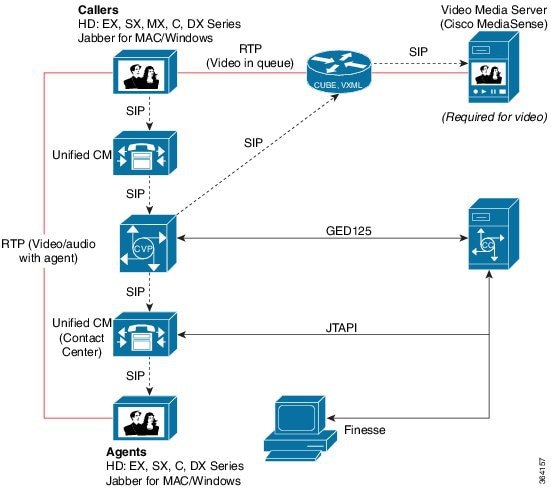Video Contact Center
Video Contact Center provides high-quality video collaboration between customers and agents. Depending on how Video Contact Center is deployed, customers may connect with agents either from within the enterprise network or from devices outside the enterprise.
Packaged Contact Center supports the following Video Contact Center capabilities:
-
Video communication between agents and callers
-
Video on Hold - Videos are played to callers when they are placed on hold by an agent.
-
Video-in-Queue - Video-in-Queue can play videos before and while a caller is in queue. This feature presents high-definition video prompts that allow callers to navigate a video menu using DTMF keys.
-
Cisco MediaSense recording - Packaged CCE supports audio recording; video recording and playback is not supported.
Packaged CCE supports four Video Contact Center deployments:
-
Video Contact Center for enterprise callers
-
Video Contact Center with Jabber Guest
-
Remote Expert Mobile
-
Remote Expert Branch, including Kiosk/Immersive
 Important |
This guide does not discuss Remote Expert Branch or Remote Expert Mobile. For all information about the Remote Expert Mobile deployment for Packaged CCE, see the Cisco Contact Center Solutions and Unified Communications Manager Solution Configuration Guide for Remote Expert Mobile, available at https://www.cisco.com/c/en/us/support/customer-collaboration/remote-expert-mobile/tsd-products-support-series-home.html. |
1. Video Contact Center for Enterprise Callers
You can deploy Video Contact Center so that only callers within the enterprise network can engage in video calls with agents. These callers use endpoints that are registered to the Cisco Unified Communications Manager. For example, company employees can have a video call with your IT help desk.
To transition from a voice contact center to a Video Contact Center for enterprise callers, Packaged CCE requires the following components:
-
Cisco MediaSense to store, stream, and play video content. MediaSense can also record video calls.
-
Telepresence MCU Video Conference Bridge to facilitate multi-party video conferences.
-
Cisco Unified Border Element (Cisco UBE) that connects video calls from Unified CVP to Cisco MediaSense to queue the calls or play video prompts.
-
Video endpoints for agents and callers
For example, this is a traditional voice deployment:

After the transition to Video Contact Center for enterprise callers, the deployment looks like this:

See the Contact Center Enterprise Compatibility Matrix at https://www.cisco.com/c/en/us/support/customer-collaboration/packaged-contact-center-enterprise/products-device-support-tables-list.html for the supported versions of these components.
2. Video Contact Center with Jabber Guest
Packaged Contact Center Enterprise supports Video Contact Center with Jabber Guest as an add-on to Video Contact Center. In Video Contact Center with Jabber Guest, callers outside the enterprise network use a Cisco Jabber application or browser client for video calls with agents.
In addition to the components required for enterprise callers, Video Contact Center with Jabber Guest deployments also requires these components:
-
Cisco Jabber Guest Server, to connect Jabber client video callers with agents.
-
Cisco Expressway Edge and Core, to enable Jabber client traffic to reach the Jabber Guest Server through the enterprise's firewall.
After the transition to Video Contact Center with Jabber Guest, the deployment looks like this:

See the Contact Center Enterprise Compatibility Matrix at https://www.cisco.com/c/en/us/support/customer-collaboration/packaged-contact-center-enterprise/products-device-support-tables-list.html for the supported versions of these components.







 Feedback
Feedback